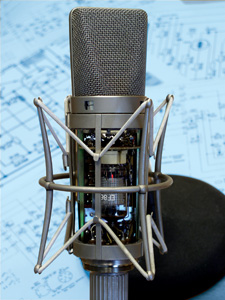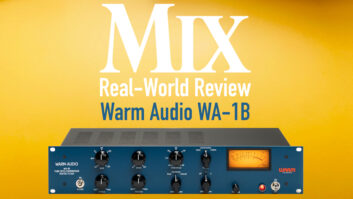
A Neumann U67 with EF86, a pentode wired as a triode
Wines have been to known to improve with age, but what happens to a microphone after 50 years or so? A vintage mic with that special “something” is unlikely to sound the same as it did a half-century earlier. The sound will be similar, yes, but whether the user feels it sounds better or worse with age may be highly subjective and may depend on the application.
You might be too love-blind about a mic that rocks your world to notice its decline until it needs specialized care. Then the question will be, “What are my options and to what degree can the options be manipulated so that the mic comes back to life the way I’d like?” Notice that there are options; some are under our control, some are more spendy than we’d like.
In vintage tube mics, the signal path is very direct. Between the vibrations in the air and the output connector are six components: grille, capsule, vacuum tube, capacitor, output transformer and cable. There’s also a power supply, a handful of resistors and other capacitors, but two of these sonically critical components — tubes and capsules — are subject to aging factors and availability. Each imparts a sonic signature so recognizable that the technician’s challenge gives new meaning to the phrase “First do no harm.”
If you suspect the problem is with the tube (generally a user-serviceable part) or have already made a swap with no improvement, then before proceeding consider the plight of the capsule. Its life begins subject to the manufacturing tweaks and tolerances of the production line. Then add the sonic equivalent of Hurricane Katrina and Mt. St. Helens — rock star breath and explosive spit, two aging accelerators that gradually migrate the capsule’s character outside of the “factory tolerance window.” From any perspective, vocal mics and kick drum mics have a tough existence.
All condenser mics will inevitably need a tune-up; the most typical problems are breath sensitivity (humidity) and random noises. When both of these issues are related to capsule condition, the three options for repair/restoration require a specialist’s expertise. In order from least to most dramatic possible change and/or improvement, the options are cleaning, reskinning (new diaphragms) or replacement.
Cleaning usually reveals the “hidden damage.” Scarring of the gold coating may not be pretty, but it’s not cause for alarm like missing gold or a puncture wound might be. In such cases, reskinning is your best shot at preserving character. The predetermined magic stems from how the brass backplate was drilled, combined with the spacer thickness between the diaphragm and the backplate. Variables include diaphragm thickness and tension, and when the initial work is done, your warm, dark-ish, tastefully airy vintage mic may brighten up and tighten up. Tubes can have a similar effect. Then the tweaking begins.
Every page of Mix could be filled with mind-numbing details on the subject, but the short story is that a mic capsule is a Helmholtz resonator at the microscopic level. Imagine the challenges the original designers faced when the three primary ingredients were knowledge, a slide rule and time to experiment. No modeling software — just trial, error and word-of-mouth.
Vacuum-Style Variables
When microphone noise is not capsule-related, the next wear-item in the chain is the vacuum tube. If you didn’t know, New Old Stock (NOS) is the phrase that refers to tubes that are made rare and spendy by collectors and manufacturers who have scarfed up the best (or large quantities). The remaining NOS has either been picked through or deemed less likely to yield a winner, so truly exceptional tubes are increasingly rare. If you have the resources and a reliable NOS source, that’s great, However, I wouldn’t pay top dollar for an untested tube, no matter how many stars are on it.
When you don’t have the NOS resources, the alternate philosophy is to take advantage of current production tubes — not simply because some can do the job, but also because the expertise of vacuum tube manufacturing will not live and prosper if we don’t support it.
Not all vintage gear is necessarily classic, nor do all NOS tubes have low noise, low microphonics (mechanical sensitivity) or great tone. Production and material variations yield a bell curve, and nowhere is this more obvious than with vacuum tubes. Finding an exceptional tube (NOS or modern) requires buying sizeable quantities, sorting for low-noise/microphonics and then burning-in the candidates for at least 24 hours — if not several days. From this subgroup, the winners are then regraded for noise and evaluated for sonics, and then burned in again.
Quite often, just finding a low-noise tube is acceptable, especially for AKG C-24 owners who need both sections of a 6072 dual-triode to be quiet. (The AKG C-12 and ELA M-251 only use half of the 6072.) Untested NOS tubes are at least four times the price of current production versions, which means you can buy 10 new tubes for the price of two NOS tubes. Any tube that isn’t microphone-grade can be used in less critical applications, such as in mic preamps, EQs or guitar amps.
End Game
While we needn’t be fearful of changing components, we should be prepared when the need arises because the resurrection results can range from better, same, different or worse than “the way it sounded before it stopped working.” Your go-to mic may have evolved to its current state through some combination of aging and previous repairs.
If your classic mics are essential to your sound, consider embarking on a sample library expedition that highlights what makes each mic special before they bite the dust or become unrecognizable. When it gives up the ghost, your ability to communicate — and provide samples (recording history) — can make the job easier for those entrusted with “maintaining the magic.” For that very special microphone, the phrase “good as new” takes on an entirely new meaning.
For more Eddie, visitwww.tangible-technology.com.
AUDIO SCIENCE
Tube Terms, Types and Technology

One feature common to vintage tube mic designs is circuit simplicity. In the schematic shown, the principle tube components are the heater/filament, cathode, grid and plate, while the latter three (or more) components add up to define a tube’s type, whether it is triode (three), tetrode (four) or pentode (five). The plate resistor is a critical passive component and is one of the most commonly replaced pieces in vintage tube gear repair.
The two most common tubes used in microphones are the 6072 (12AY7) dual-triode and the EF86 (6267), a pentode wired as a triode. Others in the 12A?7 Series are also used. Tubes often have two or more “names” as shown, either to denote country of manufacture (USA or Euro) or class/quality (consumer or military/commercial); both of these are 9-pin “miniature” tubes. The EF86 is used in the “export” version of a Neumann U67, while the Euro/broadcast version of that mic, the M269, uses the AC701, a subminiature triode (with wires instead of pins). Other vacuum tubes found in microphones include 6AK5/5654, 6AU6/6136, 6CW4/13CW4, 7586, EF-12, EF-14, VF-14, 6C315-P and the 9002/6s1p (6c1n).







